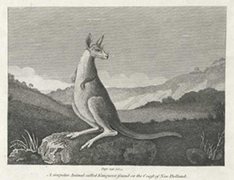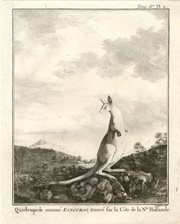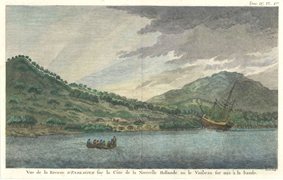 Better equipped voyages had a trained artist, but when one was not available a member of the ship’s crew was appointed for this task. Illustrations were hand-drawn until the early 19th century invention of the camera. Inevitably, drawings varied in competency. Accurate portrayal varied with artist's observational ability and artistic skill in creating a faithful illustration. Some artists used watercolour to bring special images to life. When scientific realism was not involved, personal artistic interpretation sometimes took over - with some rather strange results.
Better equipped voyages had a trained artist, but when one was not available a member of the ship’s crew was appointed for this task. Illustrations were hand-drawn until the early 19th century invention of the camera. Inevitably, drawings varied in competency. Accurate portrayal varied with artist's observational ability and artistic skill in creating a faithful illustration. Some artists used watercolour to bring special images to life. When scientific realism was not involved, personal artistic interpretation sometimes took over - with some rather strange results.
Wildlife sketches were usually more difficult when the subject did not remain still, in one place, long enough for a full sketch to be made. Early professional collectors frequently solved this problem by shooting the bird or animal, sketching or describing the habitat, and sending the skin and any relevant information to Europe for recording and identification. This inevitably created problems as life imbues each animal with its distinctive characteristics.
Previously unknown animals were often misinterpreted and inaccuracies perpetuated until improvements were made. Each artist’s sketch was a subject for an engraved plate to be made to enable illustrations to accompany the 18th and early 19th century publication of journals of voyages. Illustrations published centuries ago are known as antique prints. The earliest ones were printed on hand-made paper from engraved inked-plates that had been carved in reverse from a mirror image to enable the subject to be printed in the direction of the original drawing.
Sometimes an engraver was sceptical of the accuracy of a scientific sketch received from a voyage. A taxidermist sometimes forced an unfamiliar animal's skin into a more familiar shape, and stuffed kangaroo skins, though larger, were reminders of more familiar rats. The most famous and collectable strange portrayal of Australian fauna is undoubtedly the 'Kanguroo' that was first sighted during Lieutenant James Cook's discovery and charting of the east coast of Australia while Cook's ship Endeavour was being repaired near Cooktown in north Queensland after being damaged on the Great Barrier Reef.

The King had approved and contributed to that joint Royal Society and Admiralty voyage of discovery, but keen naturalist, wealthy young Joseph Banks had funded a larger portion of the voyage and employed eminent scientists and professional artists. After the voyage Banks commissioned George Stubbs, R.A. (famous for his horse paintings) to do an oil painting of the kangaroo. Stubbs had the stiff lifeless skin wet, stuffed, and stitched, so that he could paint it.
When his painting was displayed in London it caused a sensation! Stubbs’s Kongouro from New Holland together with his painting of a dingo, Portrait of a Large Dog, fetched 9.3 million Australian dollars when sold together at auction in 2012. The winning bid was made by the National Gallery of Australia, but export from Britain was refused. With the assistance of Sir David Attenborough, these treasured paintings from Captain Cook's voyage have since been purchased by the National Maritime Museum in London and are on display at Greenwich.
Copperplate engravings of the “Kanguroo” were made from Stubbs’ painting, so that the engraved image could be included in accounts of Cook’s voyage. The discovery of the east coast of Australia was so greatly anticipated worldwide, that information from Cook's voyage was included in travel publications in other countries. This copperplate engraving (top left) was first published in London in 1773, and re-engraved (at right) for publication in Paris c1774.
Wonderful Australian marsupials Antique Prints can be found in Australian Animals under Australian Nature. The illustration at top left has been framed in a poplar frame with conservation ragmat board.